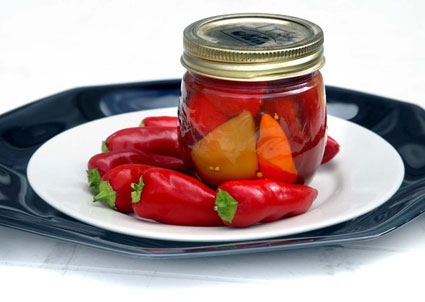|
|
Backslide Picklesby Ari LeVaux To be clear, this was backsliding, and not a permanent return to my old ways. I’m sold on exploring the huge world of fermentation, with its new flavors, health advantages and all-around fascinating concept. While vinegar preserves food by killing, fermentation preserves by promoting microbial life. Fermentation creates con That same acidic environment is what pickles the food the microbes are growing on. In fact, vinegar is a fermentation product. It was with pickled carrots and jalapeños, or simply “pickles,” as I called them, that I first learned the pleasures of munching pickles with many types of rich, fatty foods, from scrambled eggs to eggplant parmesan to steak with mayo. Like an aboriginal hunter utilizing every bit of his kill, I wasted nothing from the pickle jar. Once emptied of its peppers and carrots, the vinegar was used in salad dressing or marinade. And the vinegar-soaked mustard seeds at the bottom of the jar were ground in a blender, with turmeric and paprika, into mustard. Upon purchasing my red jalapeños, I already had everything else I needed on hand. The vinegar, sugar and salt were on the shelf, and the carrots were easily dug from the garden. Rings and lids were right where I’d left them, forgotten but not gone, as were bags of mustard seeds. The process was as familiar and easy as slipping into bed with an ex-lover.
Add a teaspoon of salt and a tablespoon or two of mustard seeds to the bottom of each empty jar. Pack peppers and veggies into jars as tightly as possible, leaving a 1-inch headspace. Add any extras like grape leaf, garlic, onions and oregano along with the veggies. When the jars are packed, heat your brine. The more space-efficiently you’ve packed the jars the less brine you will need. I can eyeball a group of packed jars and heat up the right amount of brine, but it never hurts to err on the side of extra brine, which can be saved for later. Generally speaking, you need between a half and three-quarters of a jar of brine per packed jar of pickles. The brine consists of equal parts vinegar and water. As it heats, add sugar to taste, a little at a time until it softens the edge of the vinegar but doesn’t make it taste sweet. When the brine boils, turn off the heat and pour it into the jars, covering the veggies by half an inch, which should leave another half-inch of headspace. Wipe any stray mustard seeds from the rims. Process in a water bath for 5 to 10 minutes, or simply hot pack it. My adventure with pickled carrots and jalapeños was the first time I had used my canning gear since I began exploring fermentation. And while I’m excited for the fermented road ahead, I won’t be ditching my kettle and tongs along the way. You never know when the vinegar urge might strike again. |
In this week's issue...
- May 15, 2025
- End of the trail
Despite tariff pause, Colorado bike company can’t hang on through supply chain chaos
- May 8, 2025
- Shared pain
Dismal trend highlights need to cut usage in Upper Basin, too
- April 24, 2025
- A tale of two bills
Nuclear gets all the hype, but optimizing infrastructure will have bigger impact


 ditions that favor the growth of healthy germs like lactobacillus. They make the environment more acidic, which prevents the growth of dangerous microbes.
ditions that favor the growth of healthy germs like lactobacillus. They make the environment more acidic, which prevents the growth of dangerous microbes.